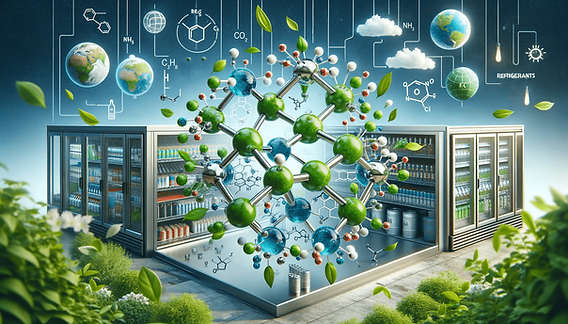No products in the cart.
Other Info
The Rise of Natural Refrigerants: What You Need to Know
In recent years, the HVACR industry has witnessed a significant shift toward sustainability. One of the most notable trends is the rise of natural refrigerants. These eco-friendly alternatives are gaining traction globally. But what exactly are natural refrigerants, and why are they so important? Let’s dive in.
What Are Natural Refrigerants?
Natural refrigerants are substances that occur naturally in the environment. Unlike synthetic refrigerants, they have minimal environmental impact. Common examples include ammonia (R717), carbon dioxide (R744), and hydrocarbons like propane (R290). These refrigerants are non-toxic, energy-efficient, and have low global warming potential (GWP).
Why Are Natural Refrigerants Gaining Popularity?
The demand for natural refrigerants is driven by several factors. First, global regulations are tightening. Governments are phasing out synthetic refrigerants with high GWP. For instance, the Kigali Amendment aims to reduce hydrofluorocarbon (HFC) use by 80% by 2047.
Second, businesses are prioritizing sustainability. Consumers now prefer eco-friendly products. Companies adopting natural refrigerants can enhance their brand image.
Lastly, natural refrigerants are cost-effective in the long run. They are energy-efficient, reducing operational costs. Plus, they are abundant and inexpensive compared to synthetic alternatives.
Key Benefits of Natural Refrigerant
- Environmental Friendliness
Natural refrigerants have near-zero ozone depletion potential (ODP). They also have significantly lower GWP compared to HFCs. For example, carbon dioxide has a GWP of 1, while some HFCs have GWPs in the thousands. - Energy Efficiency
Natural refrigerants like ammonia and hydrocarbons are highly efficient. They require less energy to achieve the same cooling effect. This translates to lower electricity bills and reduced carbon emissions. - Safety and Reliability
When handled properly, natural refrigerants are safe. Modern systems are designed with advanced safety features. For instance, ammonia systems now include leak detection and ventilation mechanisms. - Future-Proof Solution
With stricter regulations on the horizon, natural refrigerants are a sustainable choice. Investing in them now ensures compliance with future laws.
Challenges of Adopting Natural Refrigerant
Despite their benefits, natural refrigerants come with challenges.
- Initial Costs
Switching to natural refrigerant may require new equipment. This can be expensive upfront. However, the long-term savings often outweigh the initial investment. - Safety Concerns
Some natural refrigerant, like ammonia, are toxic in high concentrations. Proper training and safety protocols are essential to mitigate risks. - Limited Infrastructure
In some regions, the infrastructure for natural refrigerant is underdeveloped. This can make adoption more challenging.
Applications of Natural Refrigerants
Natural refrigerants are versatile and used in various industries.
- Commercial Refrigeration
Supermarkets and cold storage facilities are adopting CO2-based systems. These systems are efficient and environmentally friendly. - Industrial Refrigeration
Ammonia is widely used in industrial settings. It is ideal for large-scale cooling due to its high efficiency. - Air Conditioning
Hydrocarbons like propane are gaining popularity in residential and commercial AC units. They are energy-efficient and have low environmental impact. - Heat Pumps
Natural refrigerant are also used in heat pumps. They provide efficient heating and cooling solutions for homes and businesses.
Global Trends in Natural Refrigerants

The adoption of natural refrigerant is growing worldwide. Europe leads the way, with many countries phasing out HFCs. The U.S. and Asia are also catching up, driven by stricter regulations and consumer demand.
In developing countries, natural refrigerant offer a sustainable solution. They help reduce energy consumption and combat climate change.
How to Transition to Natural Refrigerant
If you’re considering the switch, here are some steps to follow:
- Assess Your Needs
Evaluate your current systems and identify areas for improvement. Consider factors like energy efficiency, safety, and cost. - Consult Experts
Work with HVACR professionals who specialize in natural refrigerant. They can help you design and implement the right system. - Invest in Training
Ensure your team is trained to handle natural refrigerant safely. Proper training reduces risks and improves efficiency. - Monitor Performance
Regularly monitor your system’s performance. This helps identify issues early and ensures optimal operation.
The future looks bright for natural refrigerant. As technology advances, their adoption will become easier and more cost-effective. Innovations in system design and safety will further boost their popularity.
Moreover, as global awareness of climate change grows, the demand for sustainable solutions will increase. Natural refrigerant are poised to play a key role in achieving a greener future.
Conclusion
The rise of natural refrigerant marks a pivotal moment in the HVACR industry. These eco-friendly alternatives offer numerous benefits, from environmental protection to cost savings. While challenges exist, the long-term advantages far outweigh the drawbacks.
By adopting natural refrigerant, businesses can reduce their carbon footprint and stay ahead of regulatory changes. As the world moves toward sustainability, natural refrigerant are no longer just an option—they are a necessity.
Are you ready to embrace the future of cooling? Start exploring natural refrigerant today and take a step toward a greener tomorrow.


